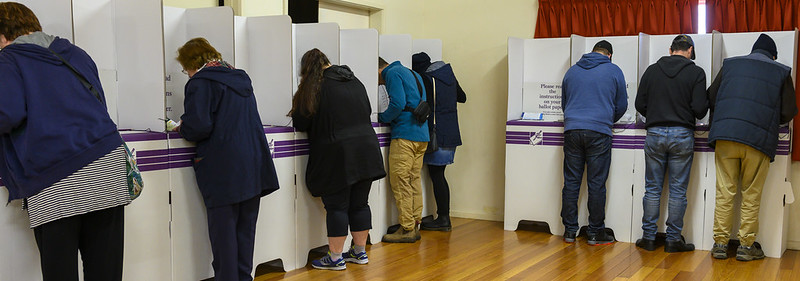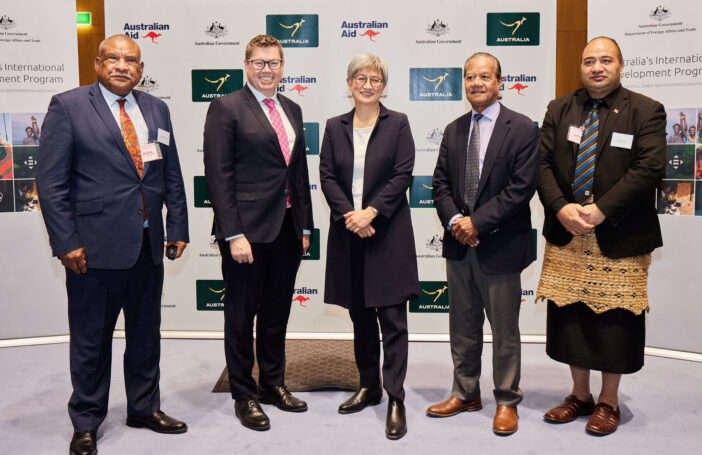The focus on aid and development, Australia’s relations with Pacific and foreign policy in the 2022 election campaign has been unprecedented. Here we take a look at what the major parties – Coalition, Labor and the Greens – have promised on aid policy and the budget.
All three parties presented their policies at International Development Election Forums in the lead up to the 21 May election. These forums were co-hosted by the Development Policy Centre, the Australian Council for International Development (ACFID) and the International Development Contractors Community (IDCC).
The Australian Greens’ spokespersons on Foreign Affairs, Senator Janet Rice, and International Development and Aid, Senator Mehreen Faruqi, joined us for the first forum on 4 May. Watch the video and read the Senators’ blog.
The ALP’s Shadow Minister for International and the Pacific, Pat Conroy, spoke on 9 May. Watch the video, read the speech and read Mr Conroy’s blog.
The Coalition’s Minister for International Development and the Pacific, Senator Zed Seselja, joined us for the final forum on 13 May. Watch the video, read the blog and read Senator Seselja’s speech.
Following is our summary of the policy and funding commitments of each party.
The Coalition
Policy commitments
The Coalition did not make any new aid policy commitments during the campaign, focusing instead on its record in supporting the region through the COVID-19 crisis.
In his speech, Senator Seselja highlighted the “over $1 billion in additional Official Development Assistance (ODA)” delivered to the region since 2020 through the Government’s “temporary and targeted” aid measures. In doing so, he noted the achievements in areas such as regional vaccination coverage, enhanced social protection in the Pacific and improved maternal and child health. He also emphasised the responsiveness of the Government’s wider support through Pacific labour mobility reforms, budget support loans for Papua New Guinea and Indonesia, and defence assistance.
Significantly, Senator Seselja also flagged that a Coalition Government would revisit the 2020 interim aid strategy, Partnerships for Recovery, should the Coalition be re-elected. He stated that “as Australia’s geostrategic environment continues to shift, it will be appropriate for a new government to lay out a new approach” and that, in doing so, “we’ll look to more fully integrate the development objectives of our ODA and non-ODA funding”.
On labour mobility, Senator Seselja also signalled that the Coalition was open to permanent migration pathways for Pacific workers and greater integration in areas such as education and training. Devpol has published a separate campaign wrap on labour mobility.
New funding commitments
The Coalition did not make any new aid funding commitments during the election campaign.
The Coalition Government did announce additional “temporary and targeted” aid for the Pacific, Ukraine humanitarian relief and global health in the March Budget, as well as a doubling of non-ODA loan funding available through the Australian Infrastructure Financing Facility for the Pacific. This increase has postponed future aid cuts to 2023-24.
Australian Labor Party
Policy commitments
The Labor Party made several specific aid-related commitments in the lead up to and during the course of the campaign. These include:
- Opposition Labor Anthony Albanese’s announcement in March that Labor will deliver a new $200 million climate and infrastructure partnership with Indonesia (it is not clear whether this would be wholly or partially funded through the additional funding package for Southeast Asia – see below)
- Shadow Foreign Affairs Minister Senator Penny Wong’s commitment that a Labor Government “will ensure that at least 80 per cent of aid spending addresses gender issues”, including tackling violence against women and girls
- Labor’s package of Pacific measures, including additional aid funding (see below) and a new Pacific Climate Infrastructure Partnership, as well as a variety of non-aid commitments, including some major announcements on Pacific labour mobility (analysed in a previous blog)
- a commitment to enhance development capabilities in the Department of Foreign Affairs and Trade (DFAT), establish a new Office of Southeast Asia in DFAT and “improve transparency and accountability in the aid program”
- the establishment of a DFAT-led review to “examine new forms of development finance and develop policy options for consideration in government”.
New funding commitments
Labor has included additional aid commitments worth $1.052 billion over the forward estimates (to 2025-26) in its final pre-election costings. This is comprised of:
- a package of additional ODA for the Pacific, worth $538.2 million over four years
- a package of additional development assistance for Southeast Asia, worth $481.8 million over four years
- increased funding for the ANCP (Australian NGO Cooperation Program) worth $31.6 million over four years.
Based on these commitments, we have recalculated our previous comparisons between Labor’s 2022 election funding announcements and the amounts needed to stabilise aid as a percentage of ODA/GNI, increase aid with inflation, increase aid by 0.01% ODA/GNI each year (as per 2021 Labor’s National Platform) and reach 0.3% ODA/GNI by 2027-28.

Labor’s additional aid commitments fall slightly short of the amount required to increase aid in line with inflation and GNI.
Labor’s 2022 election commitments are also below the additional $1.66 billion over four years that Labor promised at the 2019 election. Looking out to 2025-26, they would result in Australian aid being even further away from the 0.5% ODA/GNI aspiration contained in Labor’s 2021 National Platform than it is today (see below).
Australian Greens
Policy commitments
The Greens’ policy commitments are contained in its 2021 “Decolonising International Aid” policy. They include:
- increasing Australia’s level of international climate finance to 2025 to $4.5 billion, including $3 billion for the multilateral Green Climate Fund and $1.5 billion in climate reparations
- establishing an independent development oversight agency
- placing the human rights and self-determination of women and girls at the centre of Australia’s development assistance
- cancelling all debts owed to Australia by countries of the Global South and advocating for financial institutions and foreign governments to cancel any outstanding debt from the Global South.
New funding commitments
The Australian Greens have maintained their commitment to Australia achieving the United Nations’ endorsed target of 0.7% ODA/GNI by 2030.
According to the Greens, the Parliamentary Budget Office have costed this policy at $11.6 billion over the forward estimates (to 2025-26) and $114 billion to 2032.
Significantly, the Greens have not made aid funding one of its seven key negotiating points with Labor in the event that its support was required for the ALP to form a minority government.
Aid budget bottom line
Based on the 2022-23 Budget and the funding announcements released during the election campaign, we have revised our comparative estimates of future aid levels under the Coalition and Labor.


Based on commitments to date, the outlook for aid is certainly better under Labor but remains fairly bleak whichever party wins on 21 May. Under Labor, by 2025/26 aid will be 4% less than in 2021/22 adjusting for inflation, and under the Coalition 15% less. The aid/GNI ratio will fall to 0.18% under Labor, and 0.17% under the Coalition.




